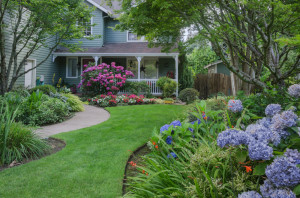Creating Landscapes That Works
Sprawling before you is a sea of green grass; one large oak tree accented by beds of nearby flowers. Along the edges of the adjoining home, rows of daisies are planted in beautiful pots providing a burst of color. Sometimes, a certain outdoor space demands your attention, its beauty somehow captivating you.
Think of basic landscaping like getting dressed in the morning, you wouldn’t want to wear a tuxedo jacket with jean shorts, or your favorite red dress with a pair of old running sneakers. The same can be said for the design of your landscape; all details must work together in order to stand out in a good way. 2 people can spend the same amount of money on basic landscaping, and one might turn out looking entirely better; what separates good landscaping from blah, is flow and style. Here we provide answers to help you create winning scenery with these 5 basic landscape design tips.
1. Solid Straight Lines Create Necessary Borders
What’s a picture without a frame? Well for starters it looks unfinished and unprofessional. Your yard can use the same borders to make an even more picturesque picture. Straight lines are considered one of the most important basic landscaping elements you don’t want to forget, without lines a garden can start to look like a mess. Lines help train the eye where to look, cleaning up the appearance of your landscape. Straight lines can be vertical, horizontal, diagonal—however you want, the important part is that some form of border is used throughout your landscaping. Bricks can be laid to form walkways that also serve as a straight-line border, large stepping-stones or rock gravel work too. You can pick a variety of borders for different parts of your garden, just so long as the overall style flows together. Learn More About Landscaping Borders.
2. Scale Basic Landscaping to Size
You don’t want to create a basic landscaping design where everything is one straight form, one solid size. Instead, you want a variety of shapes, from tall and short planters, to trees, bushes, and low sitting flowers. If everything is the same height in a garden, you might as well just plant grass and call it a day. Without size variation throughout a basic landscaping design, awesome garden elements start to get lost. Make sure that your garden speaks to all different heights, giving the eye more than just one level of plants to look at. Size variation is important, but so too are finding the proper sizes that fit together. For instance, you don’t want to plant a tree that will one day tower over your house, this will only make your house look small, as the tree takes center stage.
3. Create A Theme & Stick With It
You don’t want one half of your landscaping to look entirely different than the other half. Diversity within basic landscaping is always nice; an assortment of flowers, shrubs, and trees all mixed together can make the most intriguing display—so long as everything flows and matches. One of the largest problems people face is picking out a theme for their landscaping, instead of thinking in such specific terms, try picking out a feeling you want your entire garden to  evoke, or focus on instituting reoccurring patterns, such as a certain type of flower. If you have a lot of blue flowers in one part of your garden, make sure to incorporate little pops of that same blue elsewhere to help your landscaping flow.
evoke, or focus on instituting reoccurring patterns, such as a certain type of flower. If you have a lot of blue flowers in one part of your garden, make sure to incorporate little pops of that same blue elsewhere to help your landscaping flow.
4. The Importance Of Color
Different colors that you select for your basic landscaping design can evoke a different feeling. For instance, vibrant colors such as reds and oranges will pop out at a passerby, even drawing them in and making them feel closer to the plants. For bright landscapes, dull colors such as black, white, or charcoal make great accent splashes in the form of planters, fences, or other background accessories. For light colored foliage, try adding brighter accent pieces, such as colorful planters, or a red brick walkway. Even if you love every part of your landscaping, there is almost always a specific design element that you want to attract the most attention to; you can use a bright blast of color to draw the human eye in that direction. You don’t want your colors to go overboard though, keep a theme to the shades you choose to avoid color chaos; and remember, colors should repeat themselves throughout the entire landscape display. If you would like to discover more about landscaping principals, you can HERE.
5. Use Potted Plants
Basic landscaping design with potted plants is a must; planters add height, shape, dimension, and unique design to any space. Even a water fountain can be better integrated with the entire landscaping if it has a border of potted plants (all that match and are uniform in shape and size) around the border. Planters come in many different styles and dimensions, which means it’s easy to find the perfect design for your garden. For beginners, planters are great because they allow you to move them around, plant different things inside, and change as you go until you find a look that works. At TerraCast Planters, we offer a wide variety of top quality planters that will enhance the look of your basic landscaping design.

